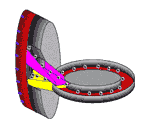Cold Heading - or hot forging for larger size
Steel wire of the required specification is feed into a cold heading machine from a coil or roll. In the machine it is cropped to length, and formed into a rough sphere by pressing between dies each of which has a hemispherical cavity. The process is called cold because it no heat is applied during the process, and heading because it is most commonly used in the production of bolts and screws to form the head. The process is simple and fast, and effective, although as the dies wear, the 2 halves of the sphere tend to become misaligned.
For larger sizes, a similar process is used, but pre-cut blanks are heated to red hot and pressed to shape using a large press.
Ceramics and tungsten Carbide balls are pressed in a similar way but using powder, and then heated under pressure to sinter of fuse the material.

Soft Reforming
The cold heading process produces ball blanks by forming the steel between 2 hemispherical cavities. The blanks are roughly spherical, but tend have a rough and flashed join line. Furthermore as the dies wear the cavities tend to become misaligned and the blanks look like two hemispheres joined together. To overcome these errors the blanks the are subjected to a soft reforming operation. This is the first of a series of processes carried out on a using a type of ball finishing machine, and has a similar effect to that of rolling putty into a ball between your hands. Ball finishing processes are carried out by machining between 2 plates, usually made of cast iron. The plates have a series of concentric grooves cut into their faces. One remains static and has a segment removed, the other rotates. Balls are feed between the plates from a hopper, travel through 1 revolution of the plate, and return to the hopper. As the process continues this action is repeated, the ball travelling through different grooves, until the desired result is achieved.

Heat Treatment
After soft re-forming, the balls undergo conventional heat treatment. Firstly the balls are heated over a period of several hours to approximately 820C. The balls are held at this temperature for a few hours then quenched in oil. After quenching the balls are re-heated to approximately 400C again held at this temperature and again quenched in oil. The first stage is the hardening process, and the 2nd tempering which removes the stresses of the hardening process imparts a high degree of toughness to the hardened balls. After heat treatment the balls have their final hardness - 58 to 62 HRC in the case of Chrome Steel Balls.
1st Lap
In their hardened state, balls after heat treatment are machined using ball finishing machines and a "lapping" process. As with soft re-forming, grooved plates are used balls being feed from a hopper through the plates and back to the hopper. In this case an abrasive is used, usually silicon carbide, and material is removed from the blanks. At the end of heat treatment, the balls would be approximately 0.2mm oversize and up to 0.05mm out of round. Over a period of approximately 8 hours the balls will be reduced in size to about 0.05mm oversize, and the roundness error reduced to approximately 0.0025mm. Similiarly size variation across the batch, which may have been as much as 0.1mm will have been reduced to less than 0.005mm. This equalization of size is a feature of the process, largely due to the random way in which balls travel through different grooves each time they go through the plate, and fact that most of the applied pressure is carried by the larger balls.

2nd Lap
The 2nd Lapping process is largely a repeat of the 1st Lap. but using a finer grade of abrasive. During this process, again over approximately 8 hours, the balls will be reduced to approximately 0.01mm oversize, the size variation to less than 0.002mm and the roundness or sphericity to less than 0.002mm. Low grade balls, Grades 100 and above, may be reduced to size during this stage, and skip the final lapping process.

Final Lap
The 3rd Lapping process is also a repeat of same process, again with finer abrasive, and reduces the ball to the appropriate size while achieving final spherical errors as low as 0.0001mm and size variation of less than 0.0002mm. It is this process that imparts the mirror finish usually associated with steel balls, although some low grade balls are barrel polished using an abrasive slurry in a machine which looks like a cement mixer.

Inspection and Grading
After finishing, the balls are subjected to a final inspection and grading process where the final batch parameters are determined. The balls are categorized in terms of sphericity, diameter in relation to the nominal size, diameter variation and surface finish. The requirement for each of these is specified in the various standards, and balls are classified against these. Balls which meet the requirements for bearing grades - grade 24 or better, are often subjected to 100% crack detection using automatic eddy current test machines.
The overall process time for a batch of steel balls is of the order of 3 days. For other materials, which are usually made in smaller quantities, and are often harder, it can be significantly longer. For example Ceramic and Tungsten Carbide balls may take up to 8 weeks if appropriate sized blanks are available, and possibly as long as 1 year if tooling has to be made to produce blanks, and then the blanks have to be produced before ball finishing can commence.